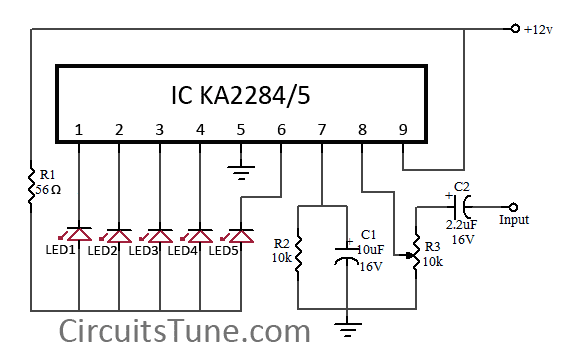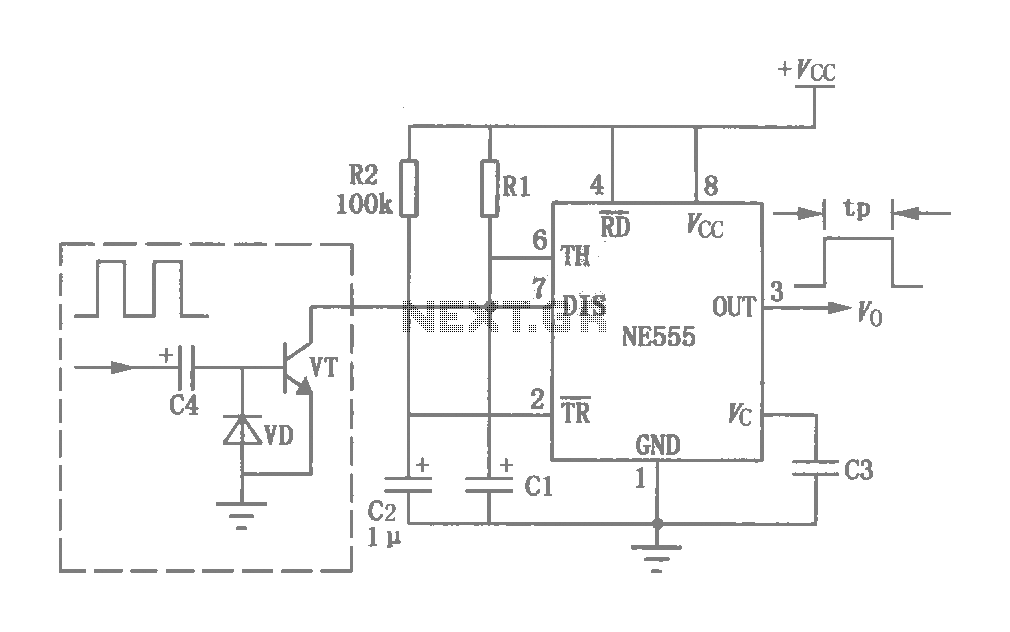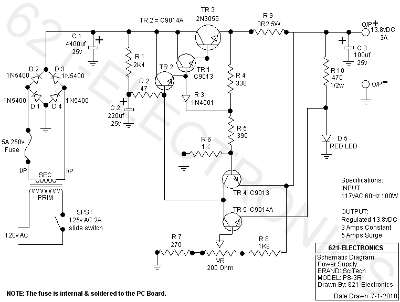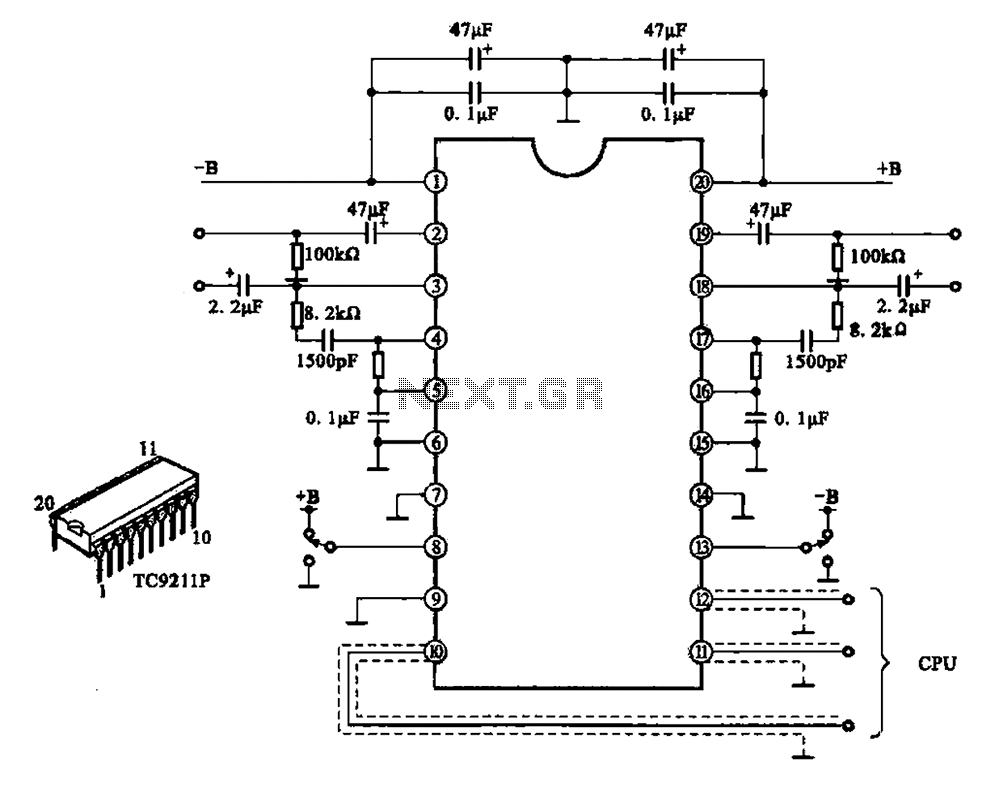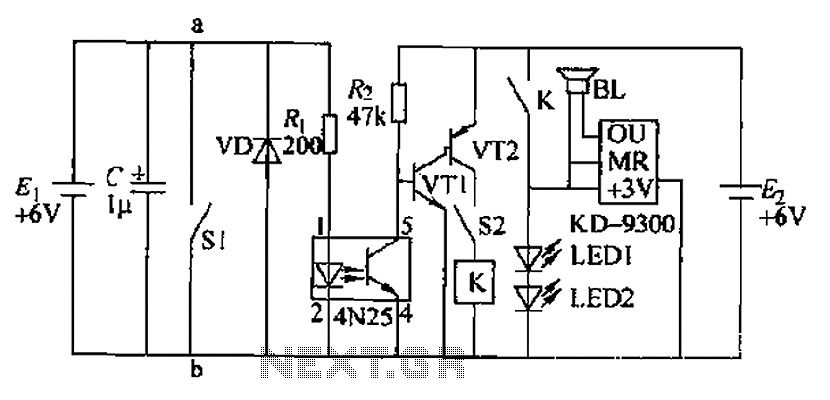
Battery Saver Circuit Circuit
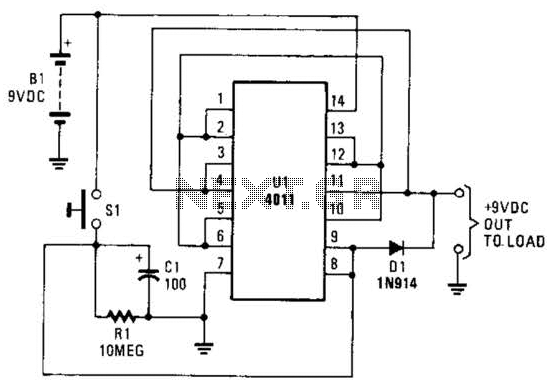
This battery saver circuit can automatically turn off a small piece of test equipment after a desired period of time, allowing for worry-free operation in a workshop environment. The circuit utilizes a CD4011 integrated circuit (IC) to function as a simple timer. One section of the IC operates as an RC discharge timer (pin 7), which causes its output to go low, thereby holding the other three outputs high and acting as a 9-V source. After the capacitor (C1) discharges over approximately 10 minutes, the output drops to zero. Switch S1 resets the circuit.
The described battery saver circuit is designed to enhance the efficiency of small test equipment by ensuring that power is conserved when the equipment is not in use. The core component, the CD4011 IC, is a quad 2-input NAND gate that can be configured in various ways to create different logic functions. In this application, one of the NAND gates is used in conjunction with a resistor-capacitor (RC) network to create a timing function.
The RC network consists of a resistor (R1) and a capacitor (C1) connected in series. When power is applied to the circuit, C1 begins to charge through R1. The time constant of the circuit, which determines how quickly C1 charges, is given by the product of R1 and C1 (τ = R1 × C1). Once C1 reaches a certain voltage threshold, the output at pin 7 of the CD4011 goes low. This low output causes the other three NAND gates to hold their outputs high, maintaining a 9-V supply to the connected test equipment.
After approximately 10 minutes of operation, the voltage across C1 drops sufficiently to cause the output at pin 7 to transition low. This effectively cuts off the power supply to the test equipment, preventing unnecessary battery drain. The circuit can be reset by momentarily closing switch S1, which discharges C1 and allows the circuit to begin the timing cycle anew.
This battery saver circuit is particularly useful in scenarios where test equipment may be inadvertently left on, ensuring that batteries are preserved and extending the life of the equipment. The simplicity and reliability of the CD4011 IC, along with the straightforward RC timing method, make this circuit an effective solution for battery management in portable electronic devices. This battery saver circuit can automatically turn off a small piece of test equipment after a desired period of time, allowing you to leave your shop worry free.This circuit uses a CD4011IC to act as a simple timer. One section acts as an RC discharge timer (pin 7). This causes ils output to go low, holding the three other outputs high acting as a 9-V source. After Cl/Rl discharges approximately 10 minutes, the output drops to zero. SI resets the circuit.
The described battery saver circuit is designed to enhance the efficiency of small test equipment by ensuring that power is conserved when the equipment is not in use. The core component, the CD4011 IC, is a quad 2-input NAND gate that can be configured in various ways to create different logic functions. In this application, one of the NAND gates is used in conjunction with a resistor-capacitor (RC) network to create a timing function.
The RC network consists of a resistor (R1) and a capacitor (C1) connected in series. When power is applied to the circuit, C1 begins to charge through R1. The time constant of the circuit, which determines how quickly C1 charges, is given by the product of R1 and C1 (τ = R1 × C1). Once C1 reaches a certain voltage threshold, the output at pin 7 of the CD4011 goes low. This low output causes the other three NAND gates to hold their outputs high, maintaining a 9-V supply to the connected test equipment.
After approximately 10 minutes of operation, the voltage across C1 drops sufficiently to cause the output at pin 7 to transition low. This effectively cuts off the power supply to the test equipment, preventing unnecessary battery drain. The circuit can be reset by momentarily closing switch S1, which discharges C1 and allows the circuit to begin the timing cycle anew.
This battery saver circuit is particularly useful in scenarios where test equipment may be inadvertently left on, ensuring that batteries are preserved and extending the life of the equipment. The simplicity and reliability of the CD4011 IC, along with the straightforward RC timing method, make this circuit an effective solution for battery management in portable electronic devices. This battery saver circuit can automatically turn off a small piece of test equipment after a desired period of time, allowing you to leave your shop worry free.This circuit uses a CD4011IC to act as a simple timer. One section acts as an RC discharge timer (pin 7). This causes ils output to go low, holding the three other outputs high acting as a 9-V source. After Cl/Rl discharges approximately 10 minutes, the output drops to zero. SI resets the circuit.
